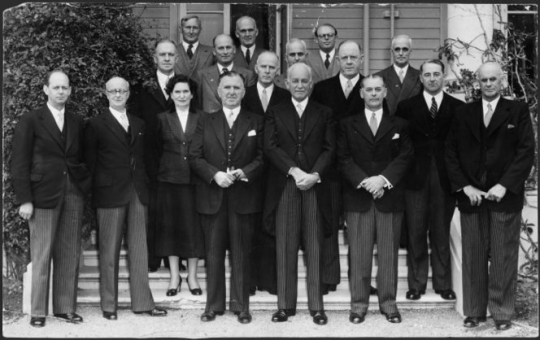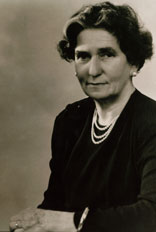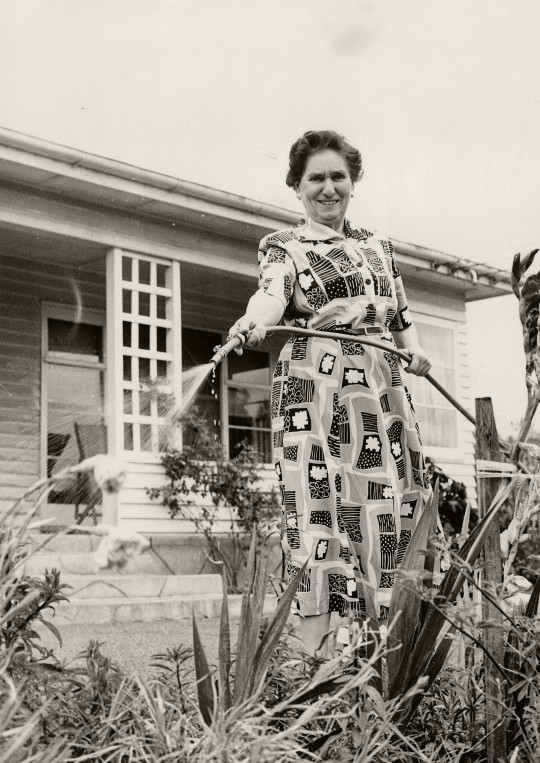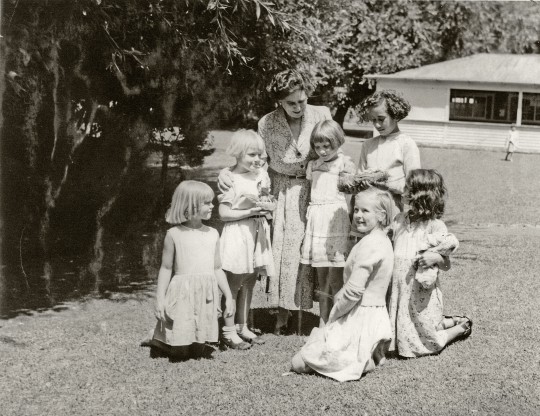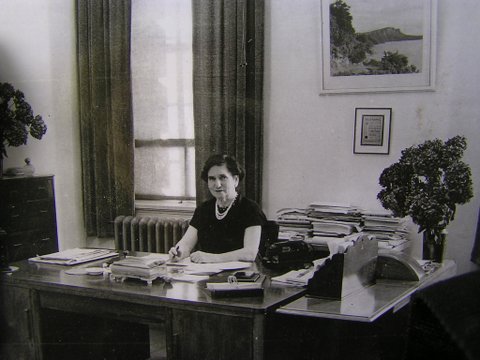Official Unveiling
The official sculpture unveiling, commemorating political pioneer Dame Hilda Ross and the centenary of the 1919 Women’s Parliamentary Rights Act took place, 31 October 2020 in Garden Place, Hamilton.
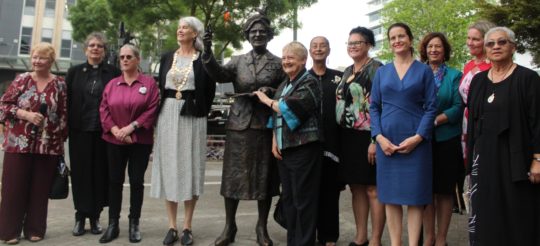
The statue, sculpted by Otaki artist Matt Gauldie, portrays Dame Hilda in Parliament, with one hand holding a copy of the 1919 Act which finally allowed women to become MPs, while the other is raised, advocating on behalf of women and children, whose welfare she considered her principal concern.
Watch the official unveiling speeches and entertainment
Thanks to our Funders
We are very thankful and grateful to the following funding organisations and people that gave us grants and donations in order to make this project possible. Thank you to Lotteries Environment and Heritage, Trust Waikato, WEL Energy Trust, Gallagher Charitable Trust, Glenice and John Gallagher Foundation, National Party, Hamilton Club, Colin Ross and Porters.
We’d also like to thank everyone who was part of the unveiling ceremony.
Dame Hilda Ross (1883-1959)
‘For the Children’
‘Mother of NZ’, popular political pioneer who tackled the hard issues with gusto; she was forthright, unremitting and hands-on, ‘a doer’ initiating action wherever the need, passionately and particularly for the welfare of children as the essence of the future. She represented New Zealand on the world stage, at the United Nations and Commonwealth.
Hilda Ross left her mark locally and nationally on most aspects of NZ society and culture: as a teacher of music, conductor & performer, in community & church affairs, in local politics and Parliament. Hers was a lifetime of community service:
“Nothing in this life is better than giving service.”
She was accorded a state funeral. On the day thousands lined city streets, 5000 her gravesite.
Dame Hilda Ross Commemoration Project
Dame Hilda Ross is one of Hamilton’s and New Zealand’s most important characters from last century. With the loss of Waikato Hospital’s Dame Hilda Ross Centre, the Dame Hilda Ross arts collection at the public library and the uncertainty over the future of Founders Theatre’s Dame Hilda Ross memorial fountain TOTI have been determined to restore Dame Hilda Ross’ exceptional legacy to the public mind.
DAME HILDA ROSS COMMEMORATIVE STATUE
TOTI originally had Council permission for a commemorative statue to be sited on the corner of Ward Street and Worley Place and council were also in favour of naming this small meeting area Dame Hilda Ross Plaza.
TOTI called nationally for artist concepts for the sculpture and after significant public consultation narrowed the entries down to three finalists, Matt Gauldie, Brigitte Wuest and Tim Elliot.
It was Tim Elliot’s concept that came up tops, however. Tim’s concept was perfectly suited to the site given to TOTI outside of Starbucks.
Read more about Tim Elliot’s concept ‘Where health joins hands with happiness’ here.
https://www.toti.co.nz/he-tangata-project/dame-hilda-ross/where-health-hol…s-with-happiness
Unfortunately, this site had challenges that were insurmountable. It required costly re-landscaping and had underground infrastructure that could not be disrupted. The creation of the bronze piano also had great challenges. It was very disappointing for Tim and TOTI that we could not move forward with his concept, and it meant we needed to ask council if another more appropriate site could be found to accommodate Matt Gauldie’s concept which public consultation had also highly favoured.
The 1919 Women’s Parliamentary Rights Act
In the meantime, we discovered an ‘almost invisible’ piece of national history, the 1919 Women’s Parliamentary Rights Act which for the first time allowed women to stand for election to the House of Representatives – to become MPs. New Zealand celebrated ‘Suffrage 125’ and women’s right to vote in 1893. But few knew women were still prohibited from Parliament before the 1919 law.
Iriaka Ratana (1905-1981)
Iriaka Ratana, the first Maori woman MP in New Zealand also kept coming to our attention as she was another political pioneer with close links to Dame Hilda. Dame Hilda Ross was elected as a National MP in 1945 and Iriaka Ratana was elected for the Western Maori seat for Labour in 1949. As our friend and advisor Pirihira Kaio (who also happens to be the first Maori woman elected to Hamilton City Council) noted “Hilda Ross and Iriaka Ratana were not only inspirational leaders, they were remarkable for their collaboration and their care for the families they represented. These were our pioneers, long-serving MPs, colleagues and friends, working together to promote wellbeing and we should remember them. Marking history like this sheds light on the political progress women have made but also inspires others to follow in their footsteps.” TOTI and our advisors then embarked on further public consultation and community conversations about the possibility of a joint commemorative artwork, which incorporated individual sculptures of each women to acknowledge their individual achievements and to also commemorate the upcoming centenary of the 1919 Act. Dame Hilda famously said, “I am far more interested in the welfare of the community than in any party political warfare as such …”
Iriaka and Dame Hilda also had attended Maori Women’s Welfare League meetings and Maori communities together during Hilda’s ministerial days. In 1958 Iriaka travelled on behalf of the government to Barbados to attend the Commonwealth Parliamentary Association conference and chose to take with her Dame Hilda Ross.
Ultimately, we could not get official sign-off from either the Tainui/Waikato Executive or Ratana. We hope Iriaka Ratana will one day also be nationally commemorated for being the remarkable woman and trailblazer that she was.
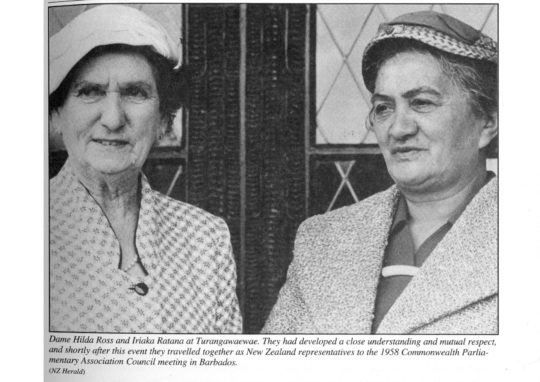
We love this photo of two of New Zealand’s extraordinary women political pioneers and is made more poignant by knowing that
- They shared a desire to create real and meaningful change for the people they represented and who needed it most.
- Both were “hands on” social activists
- Neither of them were afraid of a scrubbing brush, a broom or a hose.
- Both suffered from the sexism of the era, and faced resistance to their being in politics
- Both were musically gifted, talented pianists. Iriaka was part of the concert party that travelled to Britain. Hilda had 50 years with the Hamilton Operatic Society.
- Both knew the heartbreak of losing a child
Read more about Iriaka Ratana here
https://www.toti.co.nz/he-tangata-project/dame-hilda-ross/iriaka-ratana
Dame Hilda Ross’ Record
- 3rd NZ woman to be awarded DBE 1956
- Awarded Hamilton’s Freedom of the City 1948
- Hamilton MP 1945-59 & only woman in National Cabinet from 1949
- 1st woman councillor HCC 1944-45 & 1st woman Deputy Mayor 1945 (the year Hamilton gained city status – 20,000 people)
- Waikato Hospital Board 1941
- During the Second World War she kept the home fires burning, launching and leading the WWII Women’s Voluntary Auxiliary Corps and The Patriotic Hut in Garden Place with a group of hard working devoted women volunteers, supporting returning soldiers.
- In 1926, she co-founded heath camps for children from impoverished backgrounds; every summer for 25 years she was Camp Mother at Port Waikato Children’s Camp, cooking breakfasts for more than 200 children and organising nightly concerts.
- Music teacher, pianist, and conductor – Hamilton Operatic Society & Choral Society
Dame Hilda Ross left her mark locally and nationally on most aspects of our society and culture, with her socially and culturally responsive leadership over more than half a century. In music, song and theatre as a passionate teacher, pianist and conductor; as an innovative hands-on social activist, tending the sick in the 1918 influenza epidemic and setting up relief committees during the Depression and the 1931 Napier earthquake, launching and leading the WWII Women’s Voluntary Auxiliary Corps in Hamilton 1939-1945 and the Garden Place Patriotic Hut; in Anglican Church affairs; and in local and central government 1941-1959. Finally as an influential Cabinet Minister, and leading cross-party initiatives. Her collaborative skills were widely recognised.
She tackled the ‘hard issues’ still of concern today.
Political Pioneer
Hilda Ross pioneered women’s political involvement in Hamilton and in Cabinet. She was part of the winning group elected to Hamilton Borough Council in 1944 and the first woman. A year later as city status came, she was elected to Parliament in a by-election. In 1949 she became Minister for the Welfare of Women and Children for the first National government, claiming additional departmental responsibilities including child welfare, pre-schools, juvenile courts and women’s borstals, and the health camps. In 1957 she became Minister of Social Security.
In her Parliamentary maiden speech she made her own priorities clear:
“I am far more interested in the welfare of the community than in any party political warfare as such…”
She would later reflect her early commitment to children’s health:
“I am one of the happiest people in this House to see that we are at least trying to help the children of this country as they have not been helped for a long time”
Many of the issues of her time and concern resonate today:
- family stability and children’s need for ‘a good home life’
- violence against women and children (although she did support ‘a good spank if required’)
- the importance of the mother’s role
- healthy living and a balanced diet especially children’s lunches amidst concerns at extensive malnutrition
- welfare dependency
Hands-on and Unremitting
As an MP and Cabinet Minister, Hilda Ross’s efforts were hands-on and unremitting. She attacked transit housing and eventually lobbied successfully for a Minister of Housing. She sent a questionnaire to Magistrates to improve children’s courts, and acted on their advice. She was a leading figure in the battle against ‘juvenile delinquency’, crime and immorality, and the 1954 Mazengarb Report and subsequent legislative response by the government – including restrictions on contraception. This followed a widely publicised incident involving sexual activity among some 60 Hutt Valley teenagers (a number under 16 years).
Hilda Ross drew attention to children left alone at home or locked in cars while their parent attended functions. She called on parents to be stricter in supervising their children’s activities, and believed that parents’ attitude was the primary cause of delinquency:
“My experience has taught me that all children need careful and close attention…”
And that the Government had a welfare role:
“I think the State should come to the aid of those who are in distress and who are genuinely unable to help themselves, and I believe the help they are given should be the greatest degree possible.”
She accepted legislation could not make people ‘good’, but was confident Parliament could influence public opinion, suggesting messages in cinemas and broadcasts at race meetings.
She was selected by an American Mothers’ Committee as the 1951 NZ ‘Mother of the Year’:
“Gifted and distinguished in all other fields, always and pre-eminently they are the Mothers of Men.” (- the citation)
The Way She Saw It
Dame Hilda became a popular public speaker, known for saying it the way she saw it.
She developed a close friendship with her Western Maori colleague Iriaka Ratana, and spoke at the Maori Women’s Welfare League’s first conference in 1951. She also spoke out in Parliament against press reports of court cases identifying offenders as Maori:
“Why not say ‘a boy’, ‘a girl’ or ‘a family’? It is not fair to the good Maoris. If either Maoris or Pakehas commit offences, they are equally guilty.” (ibid)
When first elected to the Hamilton Council in 1944:
“It was like a sacrilege for the men to allow a woman to be admitted to council and to sit with such an august person as the mayor. The men have a great conceit of themselves.”
In 1952, after attending in Geneva, a UN conference on the status of women, Hilda returned with sense that women in New Zealand were advantaged, both in education and in the political arena:
“But let the women have a good say. I do not think men pay half enough attention to women’s opinions in this country.”
“I have come to realize how difficult it is for women in this country to get themselves laced to positions of authority.”
Dame Hilda had vitality, compassion, foresight and a friendly affable manner; she knew how to communicate with all aspects of society. She increased her voting majority in 1946 and 1949, and again in the 1951 snap election – even after airing her uncompromising views on her government’s stand against the waterfront workers’ strike.
In 1954 although she was 70 and had announced her plans to retire, overwhelming public support persuaded her to stand for election again, and she did so twice more, dying in office in 1959. She had declined the invitation to stand for the Hamilton mayoralty (1953).
Name Change
It’s thought she changed her name from Grace to Hilda Cuthberta to match her customary married name of Mrs H C Ross which included her husband’s initials. Her husband Harry C co-founded the furnishing firm of Barton & Ross in the Victoria Street heritage building. They had two sons.
CALL TO REMEMBER DAME HILDA ROSS THROUGH STREET NAME CHANGE
In 2017 TOTI asked the City Council to acknowledge Dame Hilda Ross by re-naming a central city street “where she can best be remembered”.
We consulted widely and the project attracted support from Parliamentarians, Mana Whenua, business people, community groups, and historians, along with Ross family descendants. In our proposal we suggested four options for consideration. Hamilton City Councillors voted unanimously to rename the east section of Ward Street (between Victoria Street and Worley Place) as Dame Hilda Ross Way. The section of Ward Street between Anglesea Street and Seddon Road is to retain its current name.
We have now submitted a Road and Open Space name/renaming application to Planning and Guidance. This application will start the notification process with affected property and business owners before a final decision is made.
CALL TO HAVE THE NEW WAIKATO DISTRICT HEALTH BOARD BUILDING NAMED AFTER DAME HILDA ROSS
TOTI have also asked the Waikato District Health Board to consider naming their new central city facility in the converted Farmers building, the Dame Hilda Ross Health Centre. Dame Hilda Ross was a co-founder of children’s health camps and her political career began as a hospital board member.
